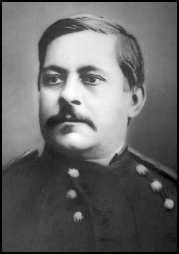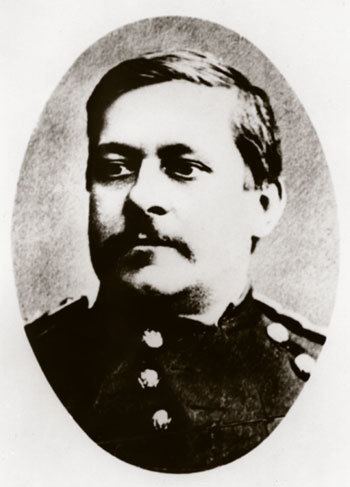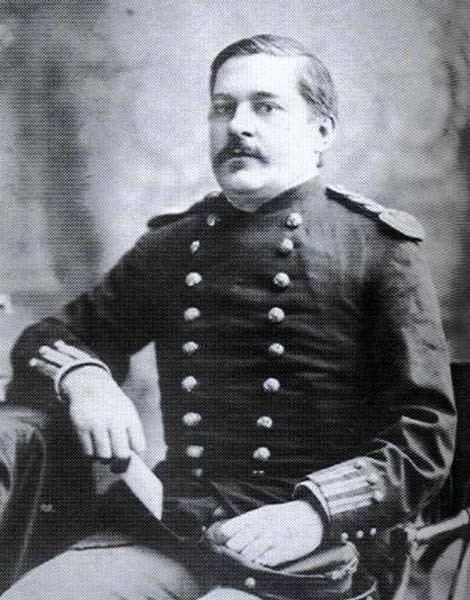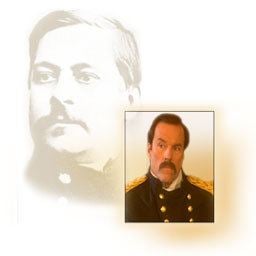Years of service 1857 - 1880 | Name Marcus Reno | |
 | ||
Born November 15, 1834Carrollton, Illinois ( 1834-11-15 ) Battles/wars Indian WarsAmerican Civil War Died March 30, 1889, Washington, D.C., United States Allegiance United States of America, Union Similar People Frederick Benteen, George Armstrong Custer, Gall, Sitting Bull, Crazy Horse | ||
Marcus Albert Reno (November 15, 1834 – March 30, 1889) was a career military officer in the American Civil War and in the Great Sioux War against the Lakota (Sioux) and Northern Cheyenne, where he served under George Armstrong Custer. Reno is most noted for his prominent role in the Battle of the Little Bighorn, which has ever since been the subject of controversy regarding his command decisions in the course of one of the most infamous defeats in the history of the United States military.
Contents
- Early life and career
- The Battle of the Little Bighorn
- Later military career
- Family
- Death military review and reburial
- Miscellany
- Portrayals in films and television
- References

Early life and career

Marcus Albert Reno was born November 15, 1834, in Carrollton, Illinois, to James Reno (originally Reynaud) and his wife, Charlotte Hinton Miller, a divorcee with one daughter, Harriet Cordelia Miller. The couple had six children: Eliza, Leonard, Cornelia, Marcus, Sophronia and Henry. His mother died June 25, 1848 after an extended illness.

His future uncertain, at the age of 15, he wrote to the Secretary of War to learn how to enter the United States Military Academy at West Point, New York. After some initial disappointment, he was admitted and attended West Point from 1851 until 1857, requiring two extra years due to excessive demerits. Reno graduated June 28, 1857, 20th in a class of 38. He was assigned to the 1st U.S. Dragoons as a brevet second lieutenant. He reported to the regiment at Carlisle, Pennsylvania on July 1, 1857. In March 1858 he was ordered to duty with his regiment at Fort Walla Walla in Washington Territory, where he reported in September 1858.

With the outbreak of the Civil war, the 1st Dragoons were renamed 1st Cavalry Regiment and transferred through Panama to Washington, D.C., arriving in January 1862. Reno, now a captain, fought in the Battle of Antietam. He was injured at the Battle of Kelly's Ford in Virginia on March 17, 1863, when his horse was shot and fell on him, causing a hernia. He was awarded the brevet rank of major for gallant and meritorious conduct. After convalescing, he returned to fight July 10, 1863 at the Battle of Williamsport.
In 1864, Reno took part in the battles of Battle of Haw's Shop, Battle of Cold Harbor, Battle of Trevilian Station, Battle of Darbytown Road, Third Battle of Winchester. Battle of Kearnysville, Battle of Smithfield Crossing and the Battle of Cedar Creek. For his service at Cedar Creek he was brevetted lieutenant colonel. In January 1865, he entered volunteer service as colonel of the 12th Pennsylvania Volunteer Cavalry, later commanding a brigade against John Mosby's guerrillas. On March 13, 1865, he was brevetted colonel in the U.S. Army and brigadier general of U.S. Volunteers for "meritorious services during the war."
Following the war, Reno served briefly as an instructor at West Point. On October 31, 1865, he became judge advocate of the Military Commission in New Orleans, bringing his family with him. On December 4, 1865, he became provost marshal of the Freedmen's Bureau there. On August 6, 1866, he was reassigned to Fort Vancouver as assistant inspector general of the Department of the Columbia. In December 1868, he was promoted to major and served on court martial duty at Fort Hays, Kansas. On July 21, 1871 he joined the 7th Cavalry as commander at Spartansburg, South Carolina. After several special assignments, he joined the consolidated regiment at Fort Abraham Lincoln in October 1875.
The Battle of the Little Bighorn
Reno was the senior officer serving under Custer at the Battle of the Little Bighorn in June 1876. Reno, with three troops, or companies, was to attack the Indian village from the south, while Custer with five companies intended to cross the Little Bighorn River farther north and come into the village from the opposite side; Custer ordered Captain Frederick Benteen with three companies to move below the Sioux camp to block the Indians from escaping to the south. Captain Thomas McDougall's troop was to bring the packtrain with ammunition and supplies. Historians believe they did not understand how large the village was. Estimates of the size of the village and the number of warriors engaged vary. After visiting the battlefield, General Nelson Appleton Miles estimated that the number of "warriors did not exceed thirty-five hundred", while Captain Philo Clark, who interviewed a number of Indian survivors, "considered twenty-six hundred as the maximum number". Miles concluded, "At all events, they greatly outnumbered Custer's command."
Reno set off for the village. Crossing the ford, he seemed uncertain. Dr. Porter, riding with him, thought it odd when Reno asked if Porter wanted his carbine. His horse was unruly and "the gun got in the way" There was initially no resistance as the soldiers skirted the timber. After "not over ten minutes" Reno unexpectedly ordered "Halt!" and "Prepare to fight on foot!"." He later explained, "I... saw that I was being drawn into some trap."
The few Indians ahead were still 1000 yards away when troops dismounted and formed a skirmish line. Soon, however, the troops were outflanked by hundreds of warriors. Reno fell back into the timber along the river. His retreat became a rout. Near the river the Arikara scout Bloody Knife was shot through the head while next to Reno. Most of the other scouts slipped away and escaped. Reno led a hasty scramble across the river and up the bluffs on the other side. There he was met by Benteen with his three companies. Clearly out of breath, Reno called out, "For God's sake, Benteen! Halt your command and help me! I've lost half my men! By this time 40 of Reno's 140 men already had been killed, 7 were wounded and an undetermined number had been left behind in the timber, although some of those abandoned would later manage to rejoin him.
Shortly afterward, they were surprised that the pursuing warriors began to turn away from them and head north. Two miles back, McDougall, marching with the pack train, heard gunfire, "a dull sound that resounded through the hills". The troops with Benteen and Reno--even Lieutenant Edward Settle Godfrey, who was deaf in one ear--also heard it. Both Reno and Benteen claimed they never heard it. Further, they did not at once advance to find out, which would later gave rise to charges that they had abandoned Custer.
Concerned with their seeming indifference and not waiting for orders, Captain Weir rode north about a mile towards the sound of gunfire to the present-day Weir Point, followed by his company. There they could see dust and smoke some three miles farther north. They first assumed it was some of Custer's men. As they watched, however, they saw warriors emerging from the smoke, heading towards them, "thick as grasshoppers in a harvest field."
Just then Benteen arrived. Looking at the situation, he realized this was "a hell of a place to fight Indians." He decided they must retreat back to their original position, now called the "Reno-Benteen defense site". Meanwhile, McDougall had arrived with the packtrain. Lieutenant Edward Mathey told Walter Camp that Reno greeted them holding up a bottle of whiskey calling out, "I got half a bottle yet.". McDougall found Reno disoriented, perhaps suffering from shock, certainly taking no interest in their precarious situation. He urged Benteen to "take charge and run the thing." Benteen quickly established a horseshoe-shaped defensive perimeter on the bluffs near where he and Reno had met earlier. They were attacked immediately and throughout the rest of the day.
As night fell the attack slackened off, while the village was alive with celebration. About 2:30 a.m., two rifle shots signaled a resumption of the attack. The firing resumed at dawn and continued until late in the afternoon, when the soldiers saw the distant village being broken up and the tribes moving south. The next morning, the 27th, the surviving troops moved closer to the river, where General Alfred Terry and Colonel John Gibbon and their forces found them. Thirteen survivors were awarded the Medal of Honor for their bravery in the battle. For Reno, criticism was his only reward. Between 1868 and 1878 there were nineteen attacks on Indian villages. Only one was unsuccessful: Reno's.
Later military career
After the Battle of the Little Bighorn, Reno was assigned command of Fort Abercrombie, Dakota Territory. There, in December 1876, he was charged with making unwanted advances toward the wife of another officer of the Seventh Cavalry, Captain James M. Bell, while Bell was away. A general court-martial hearing began in St. Paul on May 8, 1877. Reno was found guilty on six of seven charges against him, and ordered dismissed from the army. Later, President Rutherford B. Hayes reduced the dismissal sentence to two years.
Responding to charges of cowardice and drunkenness at the Little Bighorn, Reno demanded and was granted a court of inquiry. The court convened in Chicago on January 13, 1879, and called as witnesses most of the surviving officers who had been in the fight. After 26 days of testimony, Judge Advocate General W. M. Dunn submitted his opinion and recommendations to the Secretary of War George W. McCrary on February 21, 1879. He concluded, "I concur with the court in its exoneration of Major Reno from the charges of cowardice which have been brought against him." He added, "The suspicion or accusation that Gen. Custer owed his death and the destruction of his command to the failure of Major Reno, through incompetencey or cowardice, to go to his relief, is considered as set to rest...."
The court of inquiry did little to change public opinion. Enlisted men later stated they had been coerced into giving a positive report to both Reno and Benteen. Lieutenant Charles DeRudio told Walter Mason Camp "that there was a private understanding between a number of officers that they would do all they could to save Reno." In 1904, a story in the Northwestern Christian Advocate claimed that Reno had admitted to its former editor that "his strange actions" during and after the Battle of Little Bighorn were "due to drink".
In 1879, while commanding officer Ft. Meade, Dakota Territory, Reno again faced court-martial, charged with conduct unbecoming an officer because of his drinking. This time the accusation concerned peeking through the window at Ella Sturgis, the daughter of his commanding officer. He was convicted and dismissed from the service April 1, 1880.
Reno took an apartment in Washington D.C., where he doggedly pursued restoration of his military rank while working as an examiner in the Bureau of Pensions.
Family
Reno married Mary Hannah Ross of Harrisburg in 1863. She would bear him one son, Robert Ross Reno. They owned a farm near New Cumberland, Pennsylvania, in Cumberland County. When she died of kidney disease in Harrisburg on July 10, 1874, Reno was in the field in Montana's Milk River Valley. On learning of her death, he requested leave to attend her funeral and had started for home when he learned that General Alfred Terry had denied his request.
On October 20, 1882, he married Isabella Steele Ray McGunnegle of New York City. She was the widow of Lieutenant Commander Wilson McGunnegle and a mother of three adult children. Almost immediately, friction arose between the new Mrs. Reno and her eighteen year old stepson Robert. She was concerned with his excessive gambling and wild lifestyle, while he objected to her constant supervision. They were living at the Lochiel Hotel in Harrisburg where Ross had run up a large bill for his extravagances. There, on Christmas night, 1883, Robert, without invitation, entered the room of actress Carrie Swain through a window. Ms. Swain refused to press charges, but the management insisted the Renos leave. Reno sent his son to live with an uncle in Pittsburgh. The couple became estranged and over the next few years separated. Finally, Isabella brought charges of neglect, and in October 1888, she filed for divorce. The court did not immediately act on her request and in late February, 1889, Reno filed for divorce, claiming Isabella had "deserted him in February 1887".
Isabella died January 14, 1904. Robert Ross Reno married Maria Ittie Kinney in May 1885. His business ventures failed and he became a traveling salesman. Ittie seldom heard from him; when she did, he asked for money. On August 19, 1898, he sent a telegram to her brother-in-law, "Make Ittie get a divorce or I will." She filed for divorce in October; it was granted June 22, 1899. He is thought to have gone to Alaska in the Gold Rush. She lived until June 4, 1941.
Death, military review and reburial
By mid-March, 1889, Reno was diagnosed with cancer of the tongue. He was admitted to Providence Hospital in Washington on March 19, 1889 and underwent surgery the same day. While hospitalized he developed pneumonia and died at the age of 54 in the early hours of March 30, 1889. No preparations had been made for his burial, so it was arranged that he be temporarily interred at Washington's Glenwood Cemetery until he could be reinterred with his first wife at the Ross family plot in Harrisburg, Pennsylvania. No room could be found for his remains there, so his temporary, unmarked grave seemed his final resting place.
Years later, there was a move to erect a monument to Reno at the Little Bighorn Battlefield. Custer's widow Elizabeth Bacon Custer spoke out against a memorial to Reno at the site. Writing in 1926, she stated "I long for a memorial to our heroes on the battlefield of the Little Big Horn [sic] but not to single out for honor, the one coward of the regiment."
In 1967 at the request of Charles Reno, the Major's great-nephew, a U.S. military review board reopened Reno's 1880 court martial. It reversed the decision, ruling Reno's dismissal from the service improper and awarding him an Honorable Discharge.
On September 9, 1967, his remains were reinterred with honors (including a church ceremony in Billings, Montana and an eleven-gun salute at his gravesite) in the Custer National Cemetery, on the Little Bighorn battlefield. Reno was the only participant of the Little Bighorn battle to be buried with such honors at the cemetery named for his former commander.
Miscellany
At the time of his appointment to West Point, Reno was about five feet, eight inches tall, weighed about 145 pounds. He had dark hair, brown eyes and a dark complexion.
While serving at Fort Vancouver, Reno became a Freemason, joining Washington Lodge #4. He was initiated on July 6, 1867, made a Fellowcraft Mason on August 3 and raised to Master Mason on August 21, 1867.
Portrayals in films and television
Reno was portrayed by actor Ty Hardin in the 1967 film Custer of the West, and by Michael Medeirios in the 1991 television mini-series Son of the Morning Star.
Liam Sullivan portrayed Reno, with Barry Atwater as Custer, in the 1960 episode, "Gold, Glory, and Custer - Prelude" of the ABC/Warner Brothers western television series, Cheyenne, with Clint Walker in the title role of Cheyenne Bodie.
